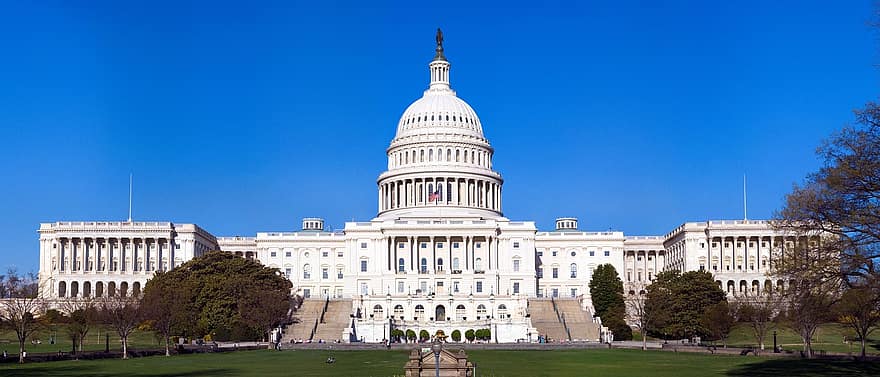Election Previews: The Senate and the Presidency up for grabs!
A look at the numbers, strategy, and trends to predict the outcome of the November 3rd elections.
September 11, 2020
With the United States being pushed to the edge because of the COVID-19 epidemic, we may be forgetting that election season is right around the corner! Many key seats in the Senate, 11 gubernatorial seats in various state governments, and the “Golden Seat” in the Oval Office will be contested. This year the election takes place on Tuesday, November 3rd nationwide. To recap on some of the rules, one-third of senators face an election every two years with a senator serving a six-year term. In the house, all 435 members face reelection every two years.
Senate
With the house looking pretty secure in favor of the Democrats, the real battleground is in local elections for Senate and for Governor in 34 states. Of those seats up for grabs in this year’s election, twelve currently belong to Democrats, while 23 belong to Republicans. Ten of those democratic Senate seats look secure with only Michigan’s Gary Peters and Alabama’s Doug Jones, who made headlines in 2018 for winning a traditionally red seat for the Democrats, could possibly lose this time around. The Cook Political Group and Politico have Michigan’s seat leaning Democrat and Alabama’s seat leaning Republican. However, things are a little more contentious across the aisle with the Cook Political Group labeling six seats a “toss-up”, one seat flipping and leaning democrat, and three seats leaning back towards Republican. If the Democrats could score big and win in four (five if Biden loses the presidential race) of the contending seven previously Republican seats, they could win control of both the House and Senate. On top of that, the Pew Research Center indicates that Senate election results reflect whom they vote for president with a 77% of states who voted for a senator and president from the same party.
Georgia
The biggest question mark in these Senate races is Georgia with both seats up for grabs in this year’s election. The seat of (R) Kelly Loeffler being subject to a jungle special election where candidates of all parties are on the same ballot. If a candidate cannot win a majority vote, a run-off election will be held on January 5th between the two top candidates. The second Georgian seat currently held by (R) Senator David Perdue, will face a stiff challenge from (D) Jon Ossoff, an investigative journalist and Georgia native. I think that the Republicans will keep Loeffler in his seat. Whether it is occupied by Loeffler or Representative Doug Collins, the other Republican candidate, is up to chance because of the unpredictable nature of Georgia’s special election. However, the Democrats have a legitimate opportunity for Perdue’s seat. While Perdue has significantly more money than Ossoff, Ossoff has proven himself as a great campaigner in his earlier 2017 special election campaign. Polls from mid-August have Ossoff and Perdue as even, or Ossoff up 2 points (within the poll’s margin of error).
North Carolina
Another important state with close margins in the polls is one of the senate seats in North Carolina. One- term Republican incumbent Thom Tillis faces reelection against state senator Cal Cunningham. In a fierce battleground state between Democrats and Republicans, the winner of this election could help Biden and the gubernatorial incumbent Roy Cooper win this state. Cunningham recently broke the Senate fundraising record with a $7.1 million dollars raised between April 1st and June 30th. Along with Cunningham’s background as an Army veteran, Cunningham could sway some moderate conservatives to vote blue. Most polls have Cunningham up as much as 7 points to as little as 1 points. This election is the definition of a toss-up, but it currently leans in favor of Cunningham. For Governor, the Democratic incumbent, Roy Cooper looks to win his reelection campaign against Republican Lieutenant Governor Dan Forest. Cooper’s corona – virus strategy of slow reopening and reliance on testing results has given the people of North Carolina more and more privileges while also ensuring that the state opens safely. These measures have polled well and are reflected in his 9 point lead over Forest. With the mail-in election taking place on Friday, September 11th, the winner of this race could begin a snowball effect for the Senate seat and ultimately, president.
Iowa
The final battleground state that could have serious implications in the Presidential election is Iowa. Early on, (R) Senator Joni Ernst led her competition. However, after Ernst supported an already debunked conspiracy theory about inflated corona – virus numbers, she quickly lost support from moderates. Sabato’s Crystal Ball from the University of Virginia Center for Politics moved the race from leaning Republican to a toss-up. The Iowa Gazette, called Senator Ernst’s comments “shameful and dangerous, but hardly surprising.” These costly mistakes could lead the Republicans to lose this Senate seat leading into the early stages of the Presidential election. If (D) Theresa Greenfield can pull away before the November election, she could help Biden secure the state.
President of the United States of America
Now for the highest office in the land, (D) Joe Biden, former vice-President during the Obama administration, wants to beat current President (R) Donald Trump. Most polls have Biden up by 5 – 12 points. But, this does not mean that Biden is a lock for the presidency. In the Electoral College, he needs to win key states like Iowa, Florida, Georgia, and Texas in order to secure his position as the next President.
Most reliable polls have Biden ahead by 1 or 2 points or even with President Trump in Florida. I believe that Florida will vote red in the Presidential Election. President Trump has a home-field advantage by registering to vote in Florida using his Mar-a-Lago Club as his primary residence despite a small hiccup with the registration process. President Trump has the funds, the location, and the means to aggressively campaign in his new home state. However, many Floridians disapprove of his Presidency with his approval polls anywhere between 40% and 43%. These low numbers of the President may be attributable to the high corona – virus numbers in Florida. Many blame the president for his inaction.
Recent polls in Texas have Trump ahead by 1 or 2 points or even with Vice President Joe Biden in that state. Expanding cities in Texas like Houston, Dallas, and Austin give more power to urban democrats. I believe Trump will win Texas based on previous voting history and the fact that Texas is seen as a Republican hstronghold. The last time Texas voted for a Democratic president was in 1976 when Jimmy Carter won by just 129,019 votes. Texas has voted Republican in 10 consecutive presidential elections. I cannot see Texas breaking that streak now. However, the margin by which the Republicans have been winning each election has slowly decreased from 27 points during Reagan’s reelection to 9 points in the 2016 election when Trump won with 52% of the vote. In that election, 6% of Texans did not vote for one of the two major political parties. If Biden can sway this population to his side along with some moderate conservatives who are not die-hard Trump Republicans, he could win Texas. But, this may be unlikely and would require a lot of resources that could be used to win states like New Hampshire, Iowa, North Carolina, or even Florida, which would be a better investment than going all-in on Texas.
Even if Biden loses both Texas and Florida, he can still win the election by taking in North Carolina, Illinois, and Arizona. The race is really close in Pennsylvania and getting those 20 electoral votes could make up for the loss of Texas and Florida. Biden is currently in a reasonably strong position. All he has to do is play defense and maintain his lead come November. He could very well help win the political trifecta :Senate, House, and Presidency for the Democrats.


























